Article and all photos by Joe Mock, BaseballParks.com
All rights reserved
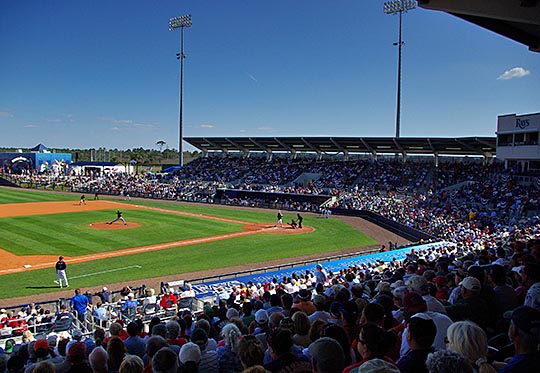 |
The 2009 baseball season is producing a bumper crop of new ballparks. Depending on how you count them (that is, should we count a “significantly rebuilt” park as being “new”?), there are eleven new playgrounds making their debuts this year. They stretch from New York in the east to Reno in the west, and from Ft. Wayne in the north to Port Charlotte in the south.
That’s a lot of miles to cover, so it’s time to get busy! Park #1 to open in 2009 is Charlotte Sports Park, located on the Gulf Coast side of Florida in Port Charlotte.
| Ballpark Stats |
 |
| Team: The Tampa Bay Rays during spring training; the Florida State League’s Charlotte Stone Crabs during the regular season |
| First game: February 25, 2009 — a 7-0 loss to the Reds |
| Capacity: 6,823, which includes 5,028 chairback seats |
| Architect: HOK |
| Construction: Hunt Construction Group and Mathews/Taylor Construction |
| Price: $27.2 million (the original park cost $5.6 million to build in 1987) |
| Home dugout: First base side |
| Field points: East by northeast |
| Playing surface: natural grass |
| Betcha didn’t know: The concourse that wraps around the outfield is a wooden boardwalk that covers nearly 20,000 square feet |
For the first time, the Tampa Bay Rays have a home field that isn’t in St. Petersburg. That’s because since the birth of the expansion team, its regular-season home games were at Tropicana Field and its spring exhibitions were ten blocks away at Progress Energy Park, better known as Al Lang Field by the countless fans who had attended spring games there over the decades.
But that has changed. The Rays — who shed the “Devil” from their team nickname and were immediately rewarded with the American League pennant in 2008 — decided that a little separation in the spring would be a good thing. Attendance hadn’t been great at exhibitions at Al Lang, plus the team wanted to nurture its fan base down the Gulf Coast from Tampa Bay. When Charlotte County proposed a completely refurbished complex, the Rays said yes.
The city of Port Charlotte already had a spring-training complex in its midst because the Rangers had trained here from 1987 through 2002, before heading west to an incredible new complex in Surprise, AZ. However, the facility that the Rangers vacated in 2002 was no showplace. I had the misfortune of visiting there during its lame-duck period, after Texas had announced it was moving. It was a grim, sterile place. The market itself didn’t really seem like much of a vacation destination for fans, and the ballpark and grounds were really subpar.
So there was no spring training here (and only scant pro-baseball use during the regular season) between 2003 and 2008, nor were any big-league clubs clamoring to spend its Marches in — or send its minor leaguers to — Port Charlotte.
That changed when the suddenly surging Rays agreed to move their spring operations south, and a $27-million extreme makeover took place. The practice fields were all refurbished to big-league standards, a brand-new clubhouse was constructed, and the main stadium at the heart of the complex was gutted and rebuilt.
Now, what was retained from the old park was much of the foundation, the steel framework that supported the roof and grandstand, and much of the roof itself. What was constructed on and around this skeleton was completely new seating including half a dozen new rows close to the field, an incredibly expanded area for the press and luxury suites, three new outbuildings for concessions and restrooms, and the aforementioned clubhouse building.
Why was the original ballpark not completely demolished and an all-new facility built in its place? Two reasons, really. First, there was a budget, and starting over definitely was not in that budget. Second, the park’s original skeleton was sound, and could take the load. “It always had great guts,” said Rays senior VP Michael Kalt to the media during a tour of the facility in January. So from great guts to greater glory — that’s the story of this baseball park.
Does this make it a “remodeled” park, or one that should be considered “new”? Well, that semantic matter is a subjective one. “I think the key to Port Charlotte is not what we saved versus what was recreated,” said David Bower, Principal at HOK Sport, architects for the stadium. “Instead, it was what we were able to do within a budget. We were able to give the Rays a like-new ballpark.”
By the way, some outlets have incorrectly called this facility Charlotte County Sports Park. That might have been its name when construction started, but along the way, the name was officially shortened. And would you like to guess who was responsible for dropping “County” from the name? That would be the County.
And a quick word about the park’s dimensions. Prior to the beginning of the spring exhibitions, the outfield fences were said to be 343′ down the lines and 413′ to dead center. Well, following the facility’s first game on February 25th, park officials remeasured the dimensions and actually changed the distance listed on the center-field wall to 414′. Rays Manager Joe Maddon noticed the change of one foot and quipped that he just hoped his batters “don’t start muscling up now.”
The Setting
The Rays’ spring park is now in an incredibly different kind of area. Previously, their exhibition games were played Bayside near downtown St. Pete. You could sit on the first-base side of the park and gaze out at the harbor on the edge of Tampa Bay. That’s why that exact spot would be the perfect site for a new retractable-roof regular-season stadium for the Rays.
Now in Port Charlotte, you’re surrounded by trees. The only water nearby is a small pond between the road leading into the complex and the third-base side of Charlotte Sports Park (see photo below).
 |
Gone is the hustle and bustle of the city of St. Pete and in its place are serene forests all around the complex. In fact, the only other business anywhere close to the ballpark in Port Charlotte is a motorcycle shop, located beyond center field.
So you wouldn’t arrive early to do some shopping or dine at a nearby cafe. Believe me, there aren’t any. But what you would do (at least during March) is arrive early to watch the players working out at the five-and-a-half practice fields that are just beyond right field of the main ballpark.
If you’re coming from, say, up North to vacation in Florida and see spring training games, would you prefer to make Port Charlotte your main destination rather than St. Petersburg or other baseball hotspots around the state? Probably not. The beaches aren’t right next door, and there aren’t nearly the the tourist-y things to do as in Orlando, Tampa Bay, Fort Myers or Fort Lauderdale.
But that’s not what’s behind the move to Port Charlotte. No, Charlotte County is the perfect choice for the Rays because it makes a trip to watch the players train and play exhibition games more of an “outing” for fans in the Tampa/St. Pete area (heck, exhibition-game attendance will easily double from 2008 to 2009), plus it’s better for the players to be away from the city in which the regular-season games are played.
From a business point of view, the Rays made no secret of wanting to cultivate more of a fan base down the coast from the Tampa area — plus the team’s Florida State League franchise is moving into Port Charlotte from across the state in Vero Beach. That not only makes it more convenient for the Rays’ brass to see the youngsters play (and facilitates rehab assignments for ailing Major Leaguers), it also makes this complex the hub of the team’s year-round player-development efforts.
All around, I think it was a great idea for the Rays to move their spring operations to Port Charlotte. It would be nice if the complex were closer to, say, I-75 (instead you have to trek across the town), but again this wasn’t a brand-new facility. It was a revitalization of an existing one, so it’s located exactly where the old place was. It’s interesting that the Red Sox’ to-be-built complex near Fort Myers will be quite close to I-75 and the Southwest Florida International Airport, making it quite convenient for the fans of Red Sox Nation. Port Charlotte didn’t have that luxury.
The Exterior
If you had the misfortune of visiting the Texas Rangers training camp between 1987 and 2002, you experienced a gloomy, sterile place. I never faulted the Rangers for fleeing to Arizona. Their digs in Surprise are so superior to what they left behind as to conjure up the chasm between night and day.
And speaking of “night and day,” that is the difference between Charlotte County Stadium circa 2002 and Charlotte Sports Park 2009. Except for the odd angles in the main seating bowl behind home plate, the place is nearly unrecognizable if you hadn’t seen it in seven years or more.
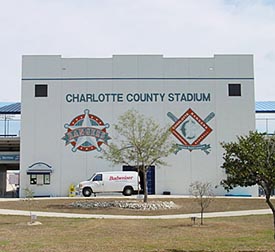  |
In no aspect of the facility is this more true than in the exterior. Above left is the main entryway when the Rangers were there. On the right is today’s version.
Now, I’m the first to admit that the main entrance to the park behind home plate is, as they say, busy. With the landscaping and the huge signs saying “Home Plate” and “Tampa Bay Rays,” it is an eyeful. But is it an improvement over the sterility of the original? The answer to that question is obvious.
What we have now is an attractive wrought-iron perimeter fence instead of the chain-link done-on-the-cheap variety previously. Also, that fence is much farther away from the main structure of the stadium. This not only gives fans much, much more room on the outer concourse, it also creates an entry plaza behind home plate once you’ve shown your ticket and entered the park proper.
By the way, the homeplate entryway isn’t the only set of gates. There is also one beyond third base, which is the one you’re likely to use if you parked across the highway in the fairground lots, and a beautifully landscaped, visually appealing entryway behind first base.
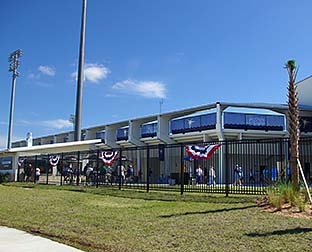  |
And in examining the “exterior” of Charlotte Sports Park, are we talking about the perimeter fence? Or the outside of the main structure? There we go with the semantics again! I say that the concourse-side of the main structure should be included in any discussion of the exterior because it is plainly visible from the street. And that part of the exterior shows the dominance of the “great guts” of the original building, as the huge concrete and steel supports are in plain view (see above right).
The Design
In giving the Rays a “like-new” ballpark, one thing that wasn’t radically different was the shape of the main seating bowl. As you can see from the Ranger days below left, the sharply angled seating rows haven’t changed greatly. What has changed is the proximity of the front row of seats to the action. That’s because half a dozen rows were constructed in front of where the foundation stopped previously — and you know how coveted seats are that are that close to the field.
Another significant change is that not a single seat or bleacher was retained from the old park, and Charlotte Sports Park is much the better for it. Gone are the faded, uncomfortable metal seats and even-more-uncomfortable benches from before and beautiful new dark-blue theater-style seats have risen in their place. In other words, there are no bleachers to be found in the new facility.
Also added are more seats down the lines and all-new viewing options from the outfield (more on that later).
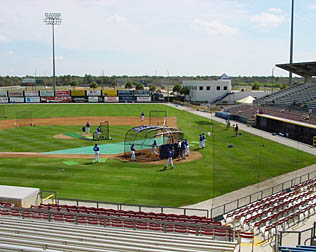 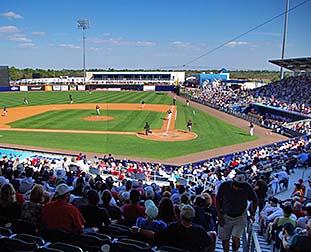 |
The large roof — very welcomed for those afternoon games when the sun can be blazing — is still there from before, but aesthetically it is much improved.
Directly behind home plate, the barely adequate press area has been transformed into media heaven, with gorgeous press boxes and a large eating/working area complete with a terrace. One floor down from the media area are five attractive luxury suites.
 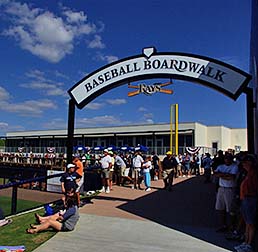 |
The new layout also allows for grass berms down both lines, with the one on the left-field side (above left) actually wrapping around the foul pole. And it’s near the foul poles where you’ll find Charlotte Sports Park’s most appealing feature, the Baseball Boardwalk.
The Rays’ delightful Vice President of Development, Melanie Lenz, took me on a wonderful tour of the facility prior to the start of the game I attended. As is always the case when I’m being given a tour of a park, I asked her to name her favorite aspect of the new facility. Without hesitating, she said it was this boardwalk. Indeed, it is over 19,000 square feet of real wood boards, providing great views of the playing field and including three group areas. Perhaps its most talked-about feature is the extremely popular tiki bar (inspired, perhaps, by the one in left field at the Phillies’ park in Clearwater). It’s shown in the photo on the left-hand side below.
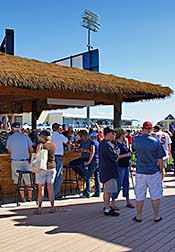 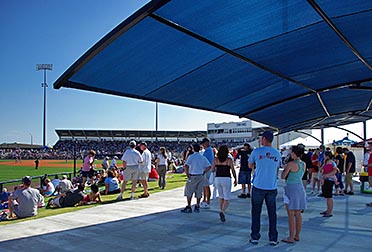 |
And as is always the case at HOK-designed parks, there are numerous “nice touches.” One I particularly liked is the canopy over the concourse near the left-field foul pole (above right). Not only does its color go well with the scheme in the rest of the park, it provides welcomed shade for a spot with an enjoyable vantage point of the playing field.
Speaking of HOK, this is a good point to add that while their design work was very good, the construction itself here is impeccable. Heavyweight builder Hunt Construction Group and local firm Mathews/Taylor both deserve a great deal of credit for their fine work.